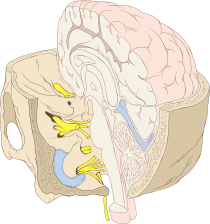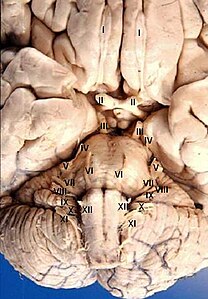Cranial nerve
As cranial nerves that are nerves called that come directly from specialized nerve cell clusters in the brain arise, the cranial nerve nuclei , mostly in the brain stem .
The other nerves in the body originate in the spinal cord as spinal nerves . The accessory nerve (XI) is an exception ; this is considered to be the cranial nerve, although part of it arises from the spinal cord. The olfactory nerve (I) and the optic nerve (II) are not peripheral nerves, but parts of the brain; however, due to the traditional view, they are still referred to as cranial nerves. The terminal nerve (0) is also a special case .
A cranial nerve can carry all different fiber qualities: somatomotor and somatosensitive as well as visceromotor and viscerosensitive as vegetative fibers . The cranial nerves supply the head area , the neck and, with parasympathetic fibers, also organs in the trunk area.
Overview
In the classic view, there are a dozen paired cranial nerves, that is, cranial nerves attached to both sides. The numbering is done with Roman numerals from rostral to caudal , corresponding to the exit point of the nerves on the brain. The classification was introduced in 1788 by Samuel Thomas von Soemmerring in his work Vom Hirn und spinal cord . The Parisian researcher Mathias Marie Duval (1844–1907) later carried out further histological investigations into the origin of the cranial nerves.
Cranial nerves in situ
| number | Surname | Coverage area | Fiber quality |
|---|---|---|---|
| 0 | Terminal nerve (terminal nerve ) | ( rudimentary in humans ) Conducts signals from the vomeronasal organ ( pheromone effect ) to the brain , innervates smooth vascular muscles | (especially) somato afferent , viszero efferent |
| I. | Olfactory nerve (olfactory nerve) | Conducts signals from the nose to the brain . | sensory (special viscera afference ) |
| II | Optic nerve (optic nerve) | Conducts the signals from the retina to the brain. | sensory (special somato affinity) |
| III | Oculomotor nerve (eye movement nerve ) | Controls four of the six external eye muscles , the eyelid lifter , as well as accommodation and the constriction of the pupil . | somatomotor and vegetative ( parasympathetic , general somatoefference) |
| IV | Trochlear nerve (roll of the eye) | Controls the oblique upper eye muscle (Musculus obliquus superior) | somatomotor (general somatoefference) |
| V | Trigeminal nerve (triple nerve ) | It is subdivided into the ophthalmic nerve ( Nervus ophthalmicus ), the maxillary nerve ( Nervus maxillaris ) and the mandibular nerve ( Nervus mandibularis ). It transmits sensitive information from all over the face to the brain and innervates the masticatory muscles . | somato-afferent and branchio-motoric (special visceroefference) |
| VI | Abducens nerve | Innervates the lateral eye muscle . | somatomotor (general somatoefference) |
| VII | Facial nerve (facial nerve) | Controls the muscles of the facial expressions and the stapedius muscle , also conveys taste perception in the front two thirds of the tongue, innervates all head glands except the parotid gland . | branchiomotor, vegetative (parasympathetic) and sensory |
| VIII | Vestibulocochlear nerve (auditory and equilibrium nerves ) | Responsible for forwarding information from the cochlea and the organ of equilibrium . | sensory |
| IX | Glossopharyngeal nerve (tongue and throat nerve) | Conducts the signals from the back of the tongue to the brain and innervates the muscles of the throat . Important for the act of swallowing . Also innervates the parotid gland. | sensory, sensitive, branchiomotor and vegetative (parasympathetic) |
| X | Nervus vagus ("wandering" nerve) | Main nerve of the parasympathetic nerve and involved in regulating the activity of many internal organs | sensory, sensitive, branchiomotor and vegetative (parasympathetic) |
| XI | Accessory nerve ("additional" nerve) | It supplies the trapezius and sternocleidomastoideus muscles . The accessory nerve actually arises from the spinal cord . However, since it pulls into the cranial cavity parallel to the spinal cord and then leaves it again at the base of the skull, it is counted among the cranial nerves. | somatomotor |
| XII | Hypoglossal nerve (sublingual nerve ) | Controls tongue movement . | somatomotor |
The cranial nerves V, VII, IX, X and XI are also known as the branchial arch nerves due to their embryological development . Their motor fiber quality is referred to as specifically visceromotor or branchiomotor (i.e. supplying the muscles that have developed from the gill arches).
Outdated names for the vestibulocochlear nerve (VIII) are the statoacusticus and otoacusticus nerves .
literature
- Hanns Christian Hopf and Detlef Kömpf (Eds.): Diseases of the cranial nerves . Thieme, Stuttgart 2006, ISBN 3-13-140111-7 .
- Michael Schünke, Erik Schulte, Udo Schumacher: PROMETHEUS LernAtlas der Anatomie. Volume 3: Head, Neck, and Neuroanatomy . 5th edition. Thieme, Stuttgart 2018, ISBN 978-3-13-242091-5 , p. 112 .
Web links
Individual evidence
- ↑ Reinhard Hildebrand: Soemmerring's work on the nervous system: a view on brain structure and function from the late eighteenth century . In: Anatomy and Embryology . tape 210 , no. 5-6 , 2005, ISSN 0340-2061 , pp. 337-342 , doi : 10.1007 / s00429-005-0027-3 , PMID 16180021 .
- ^ Reinhard Hildebrand: Rudolf Albert Koelliker and his scientific contacts abroad. In: Würzburger medical historical reports 2, 1984, pp. 101–115; here: p. 109.



